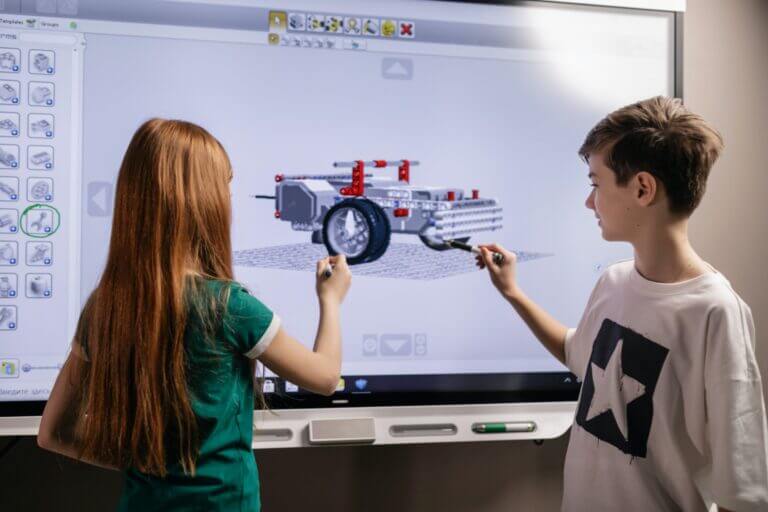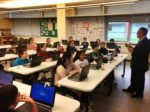As a parent, you may feel apprehensive watching the familiar education system we grew up with go through a major transformation with the addition of artificial intelligence (AI). And while some people are exhilarated by the possibilities that AI could bring to our kids’ academic journeys, other parents feel hesitant and even skeptical. If you are one of the latter, you are certainly not alone in your concerns. But there are some exciting advancements on the horizon that could truly enhance your child’s education.
To help you get a clearer picture of the role of AI in education, let’s discuss how AI is currently used in learning environments, what tools could be added in the future, and the possible drawbacks.
AI in the Classroom
In 2020, a study by McKinsey & Company revealed that teachers work an average of 50 hours per week, with only 49% of that time dedicated to direct interaction with students. Other hours went to administrative tasks, preparation, and evaluation and feedback. The report goes on to suggest that one significant benefit of AI would be to reduce the burden of administrative and clerical work, allowing teachers to redirect that time to instruction and student interaction. Here are some of the ways we are already seeing this benefit in K-12 classrooms:
- AI can grade and provide detailed feedback for assignments and tests using a set of grading guidelines, also known as a rubric. Teachers have full authority over final grades and feedback, but this helps reduce the time spent grading.
- Real-time feedback can be provided to students as they work through an assessment or lesson, which allows teachers to see when intervention is needed.
- Teachers can view classroom analytics that detail student performance and learning trends, providing helpful insights for future lesson plans and assignments.
Additionally, AI can help create a more personalized learning experience through adaptable lessons and learning materials that adjust based on a student’s personal needs and pace. If a student is not quite grasping a concept, more time or information can be provided automatically to that student.
Some schools have even found ways to use AI to increase collaboration. Teachers at K12-powered schools have shared that they use ChatGPT to generate songs or stories using content submitted by students—from story themes and plotlines to periodic table facts—which can help make learning the content engaging and fun.
AI in the Future
We are only at the cusp of AI’s impact on education. There is so much more for us to discover in terms of its capabilities, and developers are exploring new ways to enhance learning. Here are some of the big-picture ideas that we could expect for AI and the future of education, as detailed in a May 2023 report from the Department of Education (DOE):
- Lesson planning: Finding, choosing, and adapting material for lessons, in addition to writing or improving them
- Intelligence augmentation: A partnership between a teacher and AI, where AI acts as an assistant by detecting patterns, helping the teacher to make more informed decisions
- New ways to interact: More human-like interactions with AI, including an AI assistant speaking directly to a teacher or pointing out a specific aspect of a drawing or written assignment to a student
- Assisting students: Helping students with homework; acting as a partner in a small group working on a collaborative project; tutoring through adaptive step-by-step interactions; and supporting neurodiverse learners and learners with disabilities
It’s important to note that in all the examples above, teacher-student interaction is not removed. AI is used as an assistant, with the teacher and student remaining at the heart of learning. While AI has advanced rapidly, it has not and cannot replace the value of human interaction and decision-making.
Possible Drawbacks of AI in Education
The same DOE report covered possible drawbacks they are staying vigilant of as educational AI tools become available. Some concerns and limitations include:
- Possible unwanted bias or discrimination in how student patterns are determined, resulting in unfairness in decisions
- Data privacy and security risks
- Students misrepresenting work completed by AI as their own
- Lack of common-sense judgement or contextual knowledge in feedback, grades, and tutoring
- Limitations in adaptability of learning materials
- Limitations in assisting students in long-term, open-ended, creative tasks and projects
These concerns make it clear that the teacher will remain integral to the learning environment, and that AI in education will merely serve as an assistant that can enhance learning, while supporting the efforts of teachers and students alike.
After researching this topic, I reached one major conclusion: Educators care immensely about the effectiveness, personalization, and fairness of learning as well as the safety and privacy of students. And they care a lot. From the Department of Education to individual schools and teachers, educators worldwide are working tirelessly to ensure that any AI added to the learning environment fosters learning, keeps people at the heart, and protects students.
To learn more about K12-powered schools, go to K12.com.






































